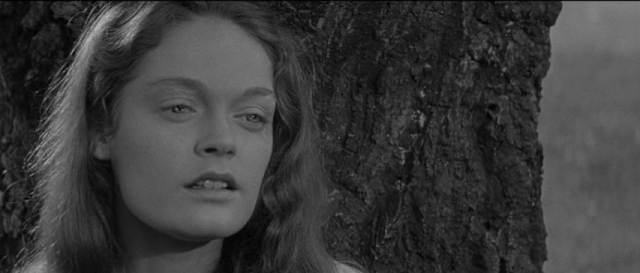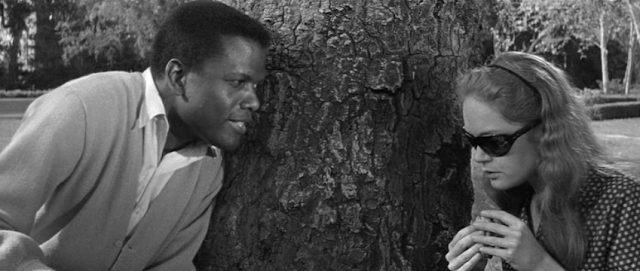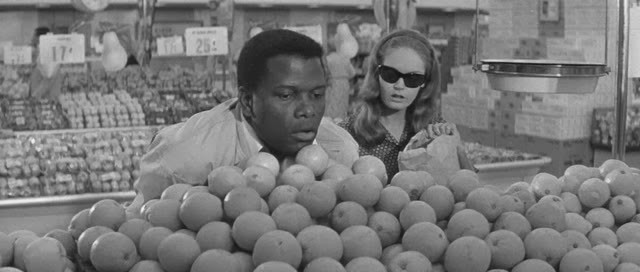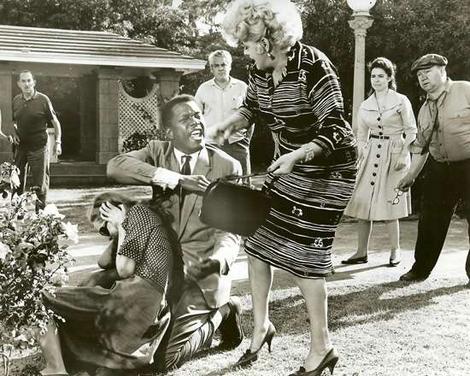It would be easy to read that synopsis–blind girl falls in love with a black man–and come to any number of conclusions about the film, especially since it was released at the height of the civil rights movement, but the film manages to capture something much deeper than being a superficial morality play on racism, and it treats Selina’s blindness with care and dignity.
When Selina was five, her father came home unexpectedly while Rose-Ann was sleeping with another man (it’s insinuated that she worked as a prostitute, and still does). Her father killed the man, and when Rose-Ann threw a bottle–a chemical-laden cosmetic–from her dresser at him, it hit Selina in the face, scarring her eyes and leaving her blind.
 |
| Elizabeth Hartman wore opaque contacts to simulate Selina’s damaged eyes. Rose-Ann is the only one who berates her “ugliness”; even her grandfather explains that it’s just that people are nosy, not that she is ugly. |
Selina’s life circumstances are desperate and miserable, but she is not. The opening shot of the film focuses on Selina’s hands, stringing together beaded necklaces–that’s what she does during the day to help her family (Mr. Faber, her boss, is presented as an important support person in her life). She yearns to spend more time in the park, and Mr. Faber takes her when he can.
It’s in the park that she meets Gordon (a caterpillar dropped down the back of her shirt and she needed help–a problem not reserved for a person who can’t see–and he helps her retrieve it). He’s friendly and gentle without being condescending, and his generosity helps strike up a quick friendship. He buys her sunglasses because she’s self-conscious about her scarred eyes and tells her she looks perfect with them on (this is presented as a generous act for her confidence, not because he actually feels she needs them).
He’s shocked that she’s never heard of braille and was never formally educated: “You haven’t heard of all blind people can do?” he asks, and she is self-deprecating yet unashamed of her lot in life.
 |
| Gordon and Selina eat lunch. |
While Selina is uneducated (Gordon corrects her grammar when they first meet) and cannot live outside of her home independently, the audience never feels pity for her because she is blind and helpless. Instead, the focus of our pity is on her lack of support–she has an abusive home life and has been neglected. Her blindness isn’t pitiful; her family is.
When Selina is shown doing tasks that she’s been entrusted with–changing linens, washing dishes, cooking, cleaning–she does so perfectly. This is a reminder that her blindness hasn’t been a hindrance to her life and that she is capable of doing what she’s allowed to do.
Hartman, in studying for the part, spent time at a school for the blind to be able to accurately get into character. She wore opaque contacts (Green said they helped because they naturally obstructed her vision), and
her family says she wore them constantly and never left character while she was filming.
This careful and empathetic approach to “acting” blind paid off. Hartman’s performance was incredibly convincing and she was nominated for the Academy Award for Best Actress (A Patch of Blue was Hartman’s first film).
 |
| Gordon helps Selina find directions by the sun’s location. |
In the film, Gordon attempts to feel as Selina must feel shortly after meeting her. He’s shown at his job–working as a night-shift reporter–getting up from his desk, walking across the room, and attempting to return to his desk with closed eyes (he is unsuccessful, and runs into his coworker’s desk). This short scene is poignant in that it further reminds Gordon–and the audience–what it must feel like to be Selina, if only for a few moments.
Gordon never tries to do things for Selina. From the beginning, he teaches her and empowers her to be able to completely take care of herself. Since it’s clear her limitations are environmental, not innate, she is capable. Her disability–caused and amplified by her family–is not what’s in her way. Her poverty and lack of support system are detrimental to her growth and development.
Gordon could have easily met Selina, befriended her, seen that she could clean and cook, and want to marry her, keeping her dependent and living simply for him. And while his romantic feelings for her are conflicted, he wants her to be independent and educated more than he wants her for himself.
 |
| Gordon gives Selina very practical advice (counting steps, listening for traffic) so she can navigate streets by herself–which she finally does, after realizing she doesn’t have to take her home life anymore. |
 |
| Gordon never belittles or gets frustrates with Selina. |
Gordon and Selina’s kiss–one of the first on-screen interracial kisses–was at the same time innocent and deeply passionate. When Selina references the fact that she’d been raped, and wishes she hadn’t so she could be with Gordon, he convinces her that she is not “bad” or “dirty,” like she worries she is. (Someone in 1965 understood how to not blame the victim.)
 |
| Their kiss was one of the first on-screen interracial kisses. |
The filmography often focuses on Selina’s point of view, and is effective in portraying the sensory details she enjoys (the canned peaches or the music box), and the terrors she lives through–her time alone for the first time on the street, or the memory of being raped (we “see” the man from her perspective–what she could have seen, but only felt).
The racial components of the film are also nuanced and effective. When Gordon tells Selina that “tolerance” is one of his favorite words (and explains that it’s not just putting up with something, but that you don’t “knock your neighbor just because he thinks or looks different than you”), she tells him that he must be full of tolerance. He quietly shakes his head and says that he’s not. He looks deeply affected when white people stare and glare at him and Selina walking together, and clearly has deep inner conflict being a black man in America in 1965 (of course, these aspects of the film don’t seem nearly as dated as they should be). His brother, a doctor, criticizes Gordon’s desire to help and educate Selina because she is white, and comments on the fact that she comes from a “trash heap” (to which Gordon responds, “She may, but she’s not trash”). Underneath the surface of the film is the fact that socioeconomic factors and family support systems are what determine a person’s opportunities.
Rose-Ann is, unsurprisingly, violently racist. We know that she forbade Selina from spending time with the only friend she ever made because the little girl was black, so we also know that when Rose-Ann sees Selina and Gordon together, she will erupt–which she does.
The characters to be despised are racist, abusive and neglectful. But Selina and Gordon aren’t perfect–they are complex, sympathetic characters who struggle with their own shortcomings and emotions. Selina is only 18, so her naivety and her quickness to fall deeply in love are believable. Gordon loves Selina as a friend, but is unsure of anything beyond that. He says he’s snapped back into reality after getting lost in their embrace. He deals with anger and frustration, too–not only because of his experiences at the hands of racism, but also because of the injustice of Selina’s mistreatment.
 |
| By the end of the film, even the crowd of white people (who before had glared), realize that Gordon is no threat to Selina; Rose-Ann is. |
The ending is hopeful, but not saccharine-sweet. The realness of the characters, their struggles and their emotions are highlighted by sparse, black-and-white film and a beautiful soundtrack.
Gordon has called a school for the blind and set up a space for Selina. Before the bus comes to pick her up, she is nervous, and wishes they could just get married. Gordon promises that in a year, they could see if their love has anything to do with marriage. He sits her down to tell her that he’s black, but she already knows.
She says, “I know everything I need to know about you.” As she feels his face she continues: “I know you’re good, and kind, and that you’re colored; and I think you’re beautiful.”
He’s shocked that she knows, and responds “Beautiful? Most people would say the opposite.”
“That’s because they don’t know you,” she answers.
A Patch of Blue portrays disability as a part of a woman’s life that only defines her because she’s grown up with an abusive and neglectful family. As soon as she gets access to a world (literally and figuratively) outside of their little apartment, she thrives, and we know she’s just going to continue to grow. She’s beginning her life–a life that won’t be defined by her blindness.
Her relationship with Gordon allows him to also redefine his own life and helps him see himself for who he is–a beautiful, kind and generous man, who knows how to share life with someone who’s never experienced it.
Fifty years later, portraying disability on screen with empathy and respect is still rare. Showing an interracial couple is also
extremely rare (Green says that some people sent terrible letters to him about the kissing scene; in fact, it’s reported that in some areas in the south the scene was edited out for theaters).
A Patch of Blue manages to weave together themes of disability, race, socioeconomic issues and family dynamics with beauty and grace. It was nominated for
multiple Golden Globes and Academy Awards; Shelley Winters won the Best Supporting Actress Oscar, and
notably, Sidney Poitier was nominated for the Golden Globe, but not an Academy Award.
A Patch of Blue is one of those films that manages to stay with you for years after you see it; and then, when you see it again, it’s just as beautiful as you remembered.
Leigh Kolb is a composition, literature and journalism instructor at a community college in rural Missouri.









Another movie to watch!